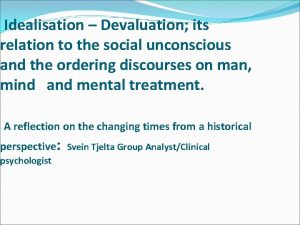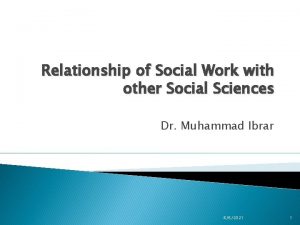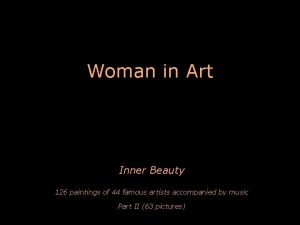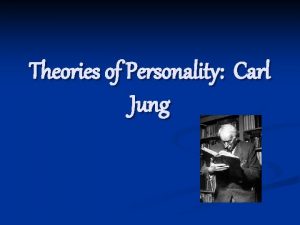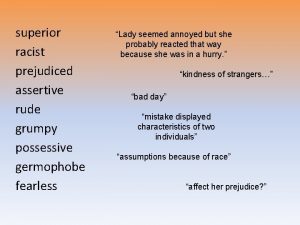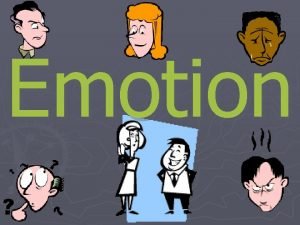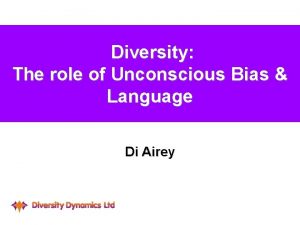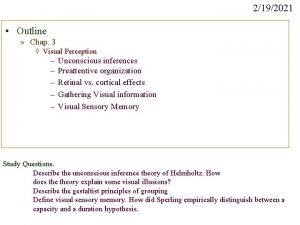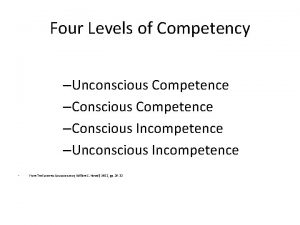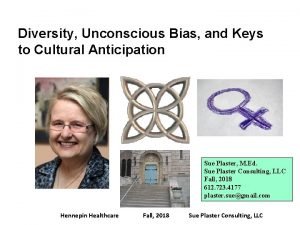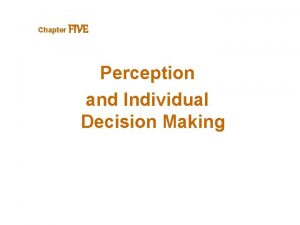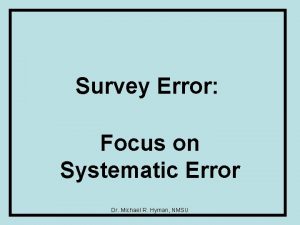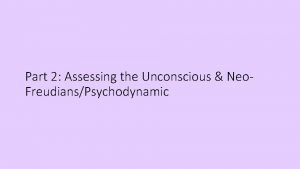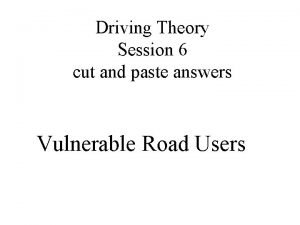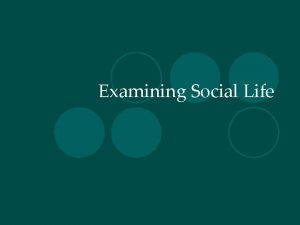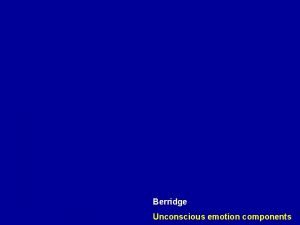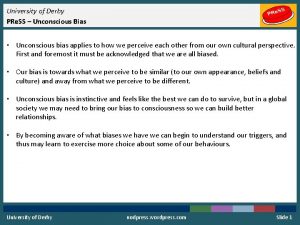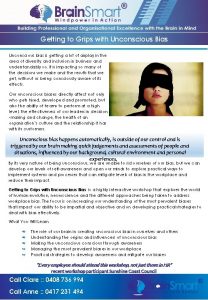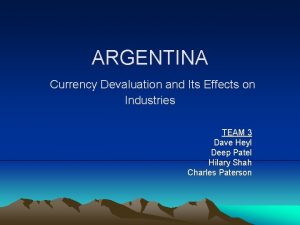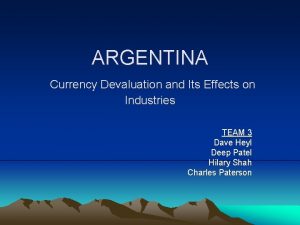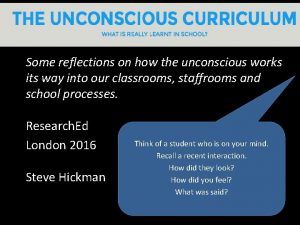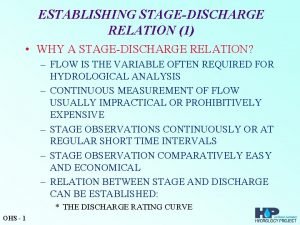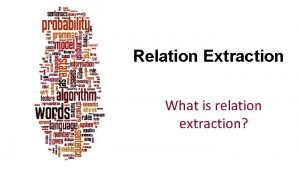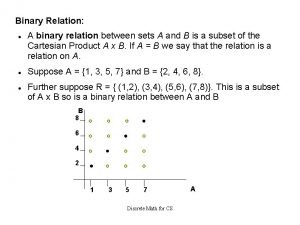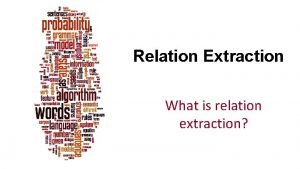Idealisation Devaluation its relation to the social unconscious




























- Slides: 28

Idealisation – Devaluation; its relation to the social unconscious and the ordering discourses on man, mind and mental treatment. A reflection on the changing times from a historical perspective: Svein Tjelta Group Analyst/Clinical psychologist

The social unconscious �The existence and constraints of social, cultural and communicational arrangements of which people are unaware. It connotes both limitations and facilitation (Hopper, 2001). �The inclusion of power relationship between discourses in the concept. The social unconscious is a discourse ordering other discourses and this ordering is also unconscious. (Dalal, 1998). �space and timelessness (Weinberg, 2007)

The relation of the Social Ucs. to Idealisation and Devaluation �Their relation to the Social Ucs. could be viewed by analogy as the manifest to the latent in the dream. The processes they define are not unconscious, on the contrary quite open, and can be interpreted from both contemporary and more recent history. �The phenomena can be observed in the place or figuration they have in the context of groups, ideas culture or society. �They could be said to be derivatives from the social ucs.

Idealisation and Devaluation �Could be seen as instrumental in the public power discourses that change ideas concerning the fashion or popular aspect of mental therapies, science as well as the more fundamental conceptualization of man. �They play a role in the ordering of things through various discourses.

Our discourses, both theoretical and practical, are embedded in ideas about nature, man and mind which are dynamic and changes with time. I will end by citing two authors’ different views of man from the conclusions they draw from their outline of ideas of man in western civilization, and give a comment.

Contexts Historical Actual sociopolitical - ideological Current cultural/societal Social unconcious Idealisation - Devaluation

Idealisation: Desire for the ideal �Psychoanalysis: psychic process where narcissisitic libido is contributing to an unrealistic positive evaluation of an object, person(s), a thing or idea. �Physics: The perfection of forms, relations and matter �Philosophy: Utopia, Platos ideal state, Webers ideal type �Economy: Assumtion of Humans as rational beeings.

Devaluation: The real too far from the ideal � Defence mechanism where there is exaggerated negative reduction of society, institutions, other people or the self. � Often occur when the idealized object or idea dissapoints or does not fulfil the demands or the desires invested in it. � A devaluation process may occur and the object is stripped of its value as idealized. � Also occuring in philosophie and economics.

“They all fall down”. Enlightenment and modernity combine in this depiction of the electric spark of liberty overturning the thrones of the crowned heads of Europe and the Pope. Devaluation of the old powers. Idealization of the new.

In session with mesmer

The Idealization of Mesmerism � 1. The rational appeal of modernity as structuring claim for truth. (Idealized figure) � 2. The desire for the other with the powers to cure.

Charcot demonstrates hysteria

The Great World Exhibition 1889 Modernism. The first International Congress for Experimental and Therapeutic Hypnotism August 1889.

Sigmund Freud 1856 - 1939

A professor is driven into a state of terror by strange intense nightmares accompanied by compulsive thoughts of murdering his wife. “Secrets of a Soul” is the first time in film that psychoanalysis was represented as a treatment for mental illness. Popular Idealization of psychoanalysis and the spreading of a new discourse in western culture and society had gained great power.

The Idealizing wave


Devaluating wave

Change in main stream psychiatry � 1. Scientific expertice � 2. Medical underpinnings (New drugs) � 3. Escape from the troublesome subjectivity of the human mind � 4. Science – cost – effect/cure in focus

To cure or not to cure �He (the Group Analyst) must make it clear from his whole attitude that he, as an individual, has no means to “cure” the patient. ……“If therapist himself, consciously or unconsciously, thinks it is his function to “cure” patients, he will feel responsible for their improvement in the wrong sense, and fails to establish the decisive change needed in their attitude. ” Foulkes 1948, Introduction to Group Analytic Psychotherapy, (p. 37 - 38)

Science and Faith healing “Too much science will kill therapy; too little science will reduce it to the status of faithhealing. The therapist must steer an uneasy course between the two, trusting to his scientific training and experience to keep him off the rocks” (Foulkes and Anthony, 1954, Group Psychotherapy-The Psychoanalytical approach)

Man as computer

The unconcious is like a fly in the soup – not supposed to be there

Some structuring principles �Standardisation: ex. Homogenues universities, professionalism, roledrilling, reproduction, conformity �Regulation: ex. Accreditation, licencing, specialisation. �Differentiation: Progressive social and institutional / organisational differentiation is a measure of civilizatory development �Fixed way of measuring quantity: Pressure for icreasing productivity, faster accumulation of results. Demands for documentation(statistics) �Fixed way of measuring quality: standard Procedures defined in codes of practice and codes of etichs. Also accreditation. �Time and money: Less time, less money

J. H. Randall jr. ”The making of the Modern Mind. ” � The picture of man as a logical machine who first thinks of some end which he desires , and then calculate the means by which that end can be attained, has given way to an infinite more complex creature of impulse and passions and emotional preference who occasionally directs his irrational desires to some intelligent end. Reason is but a fragile and weak watchdog among unruly and conflicting impulses. � Human behavior is largely determined by forces and energies which demand certain normal outlets, failing which they will give rise to disastrous conflicts and outbursts. Human nature, plastic as it is, cannot be distorted too far or changed too suddenly without danger. � Men are individuals. Social institutions must recognize that they are dealing with men, not man. � Finally, men live and develop in groups, and what they are is largely a product of the traditions and customs of the group. The group is the conditioning environment of all human action, without which all that is characteristically human would be lost. (Randall 1926, p. 518).

Peter Watson states: 82 years later in ”Ideas from Fire to Freud” �“We are entitled to doubt whether the unconscious exists. Essentially, he made the whole thing up. ”(2005, p. 728) �“THERE IS NO INNER SELF. Looking in, we have found nothing –BECAUSE THERE IS NOTHING TO FIND. We human beings are more likely to understand ourselves, by looking outside at our role and place as animals. In John Gray´s words, ’A zoo is a better window from which to look out on the human world (nature) than a monastery’. ” (2005, p. 746)

The Zoo

The Monastery
 Devaluation and idealization
Devaluation and idealization Social work relationship with other social sciences
Social work relationship with other social sciences The wave
The wave Unconscious bias questions
Unconscious bias questions According to jung the unconscious mind is characterized by
According to jung the unconscious mind is characterized by Unconscious patronization
Unconscious patronization Sigmund freud theory
Sigmund freud theory Unconscious proprioception
Unconscious proprioception Unconscious mind examples
Unconscious mind examples Psychodynamic theory examples
Psychodynamic theory examples Unconscious facial expressions
Unconscious facial expressions Unconscious bias and language
Unconscious bias and language Amber nova unconscious
Amber nova unconscious Conscious proprioception
Conscious proprioception Persona archetype
Persona archetype Auspices bias
Auspices bias Helmholtz unconscious inference
Helmholtz unconscious inference 4 levels of competence
4 levels of competence Unconscious bias icebreaker
Unconscious bias icebreaker Is an unconscious process created from distilled experience
Is an unconscious process created from distilled experience Auspices bias
Auspices bias Neo psychoanalytic theory
Neo psychoanalytic theory You should never attempt to overtake a cyclist
You should never attempt to overtake a cyclist Social thinking and social influence in psychology
Social thinking and social influence in psychology Social thinking social influence social relations
Social thinking social influence social relations Relationship of sociology with other social sciences
Relationship of sociology with other social sciences Form of emigree
Form of emigree When a train increases its velocity, its momentum
When a train increases its velocity, its momentum Sunny cloudy windy rainy
Sunny cloudy windy rainy
